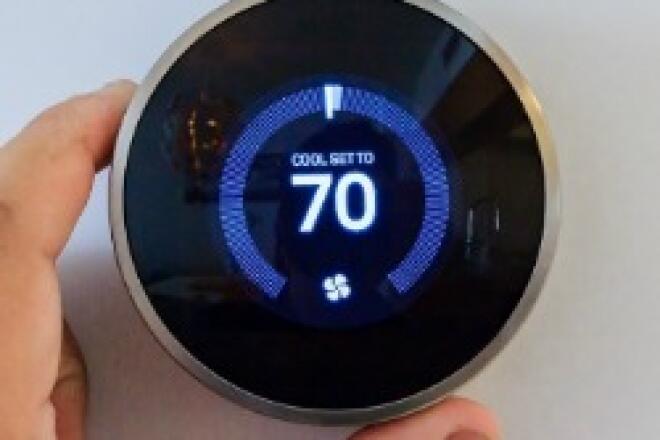
Three Spring Cleaning Tips to Improve Your Home’s Energy Efficiency
With the weather warming up around the country, it’s time that many start thinking about their annual spring cleaning checklist. This year, as you're planning for ways to deep clean, organize or just generally improve your home, don't forget to add energy-related home improvements to that list.
There are a number of easy, low-cost things that you can do to improve the overall energy efficiency of your home, saving you money on each month's bill and contributing to an overall societal decrease in greenhouse gases.
Here are a few that might be worthy of making your spring cleaning to-do list this year:
1. Upgrade that old thermostat
Okay, we're admittedly starting off with a tip that's not exactly low cost (depending on a few factors, which we’ll discuss in a second), but the proof is in the pudding: installing a smart thermostat can have an immediate and significant impact on your home’s energy usage.
According to two studies, smart thermostats could save you about 12 percent on heating and 15 percent on cooling, which, based on average energy usage and home size, would be roughly $140 in savings per year on energy bills. This figure, of course, will vary based on the size of your home, your habits and other factors. Popular smart thermostat manufacturer ecobee goes even further, suggesting that a smart thermostat can save you up to 23 percent on heating and cooling costs, or $200 or more in savings each year.
While $140+ in bill savings each year may sound pretty nice, you may be wondering about the cost of these devices. And while the top-of-the-line models aren’t exactly cheap (think $200-250), there’s still plenty of good news in the cost department in recent years.
First, ecobee and Nest, probably the top smart thermostat manufacturers today, have recently introduced models that are much easier on the wallet. The Nest Thermostat E and the ecobee3 lite both retail for $169 and offer the same core energy-saving features as their more expensive counterparts.
Second, electricity providers have offered generous rebates and discounts on smart thermostats in recent years to get these devices into their customers’ homes. Many even now offer online shopping portals where customers can immediately get $100 or 50 percent off the purchase price, making these energy-saving devices particularly appealing. Both ecobee and Nest even have rebate-finding tools on their websites where you can enter your zip code or electricity provider.
2. Do-it-yourself weatherization projects
From high tech to old fashioned, yet reliable. It would be a mistake to think that going high tech is the only way to improve your home’s energy efficiency. In fact, many of the most beneficial things you can do require just a few hours on the weekend and a trip or two to your local home improvement store.
Even if you have the latest model smart thermostat, it won’t make a significant impact if your home is leaking cool or hot air left and right. Air leaks can be a massive drain on your home’s energy efficiency, yet, fortunately, it can be pretty easy to remedy yourself.
First, you’ll want to identify exactly where the air leaks are around your home. You can do this yourself by checking for any cracks and gaps around windows, doors, attic hatches, baseboards, etc. You may be able to notice several areas where seals can be improved, but if you want a thorough and accurate measurement, you’ll need to get in touch with a professional for a home energy audit.
If you want to proceed on your own, you can use a caulk gun from your local hardware store to seal up any noticeable cracks and holes around your windows and doors. This is a pretty easy and inexpensive project that the Department of Energy suggests should take no longer than two hours and cost under $30. They even offer step-by-step instructions for you to follow here. Just by doing this quick project, you can save 10 percent or more on energy costs.
Next, you should consider adding some weatherstrips around your home. By sealing air leaks around movable joints, such as windows or doors, the Department of Energy suggests that you can save an additional five to 10 percent on your home’s heating and cooling costs, and weatherstrips are readily available at home improvement stores for a modest price.
If you don’t want to go the high-tech route of the smart thermostat quite yet, there are still a plethora of DIY projects that you can do to improve your home’s energy efficiency. When done in conjunction, these home improvements could save you 15 percent or more off your monthly power bill – and at little cost to you.
3. Swap out those lightbulbs if you haven’t yet
Finally, another tried-and-true method for improving your home’s energy efficiency – LED lightbulbs. Probably the easiest single thing that you can do around your home, installing energy-efficient lighting use just a fraction of the power (about 70 percent less) of old-fashioned incandescent bulbs. And since lighting usually accounts for 10-15 percent of home energy usage, you can expect to see some real, immediate effects on your monthly bills.

There’s more good news here. While it’s true that LED lightbulbs were expensive about a decade ago, prices have fallen considerably in recent years, as more manufacturers compete against each other to offer better bulbs at a lower price. For example, a six pack of 60-watt equivalent bulbs now sells for under $15, with each bulb being rated for a 15,000-hour lifespan.
Indeed, according to a cost analysis conducted by a nonprofit consumer organization, the typical American household can expect to save $1,000 over 10 years by making the switch – and this includes the cost of the LED bulbs. That’s roughly $8.33 each month – not bad for just changing a few bulbs.
Even more, similar to the discounts mentioned above on smart thermostats, electricity providers are keen to get these energy-efficient bulbs into the homes of their customers, and hence, many offer serious discounts through their websites. Some may even have energy-efficient bulb giveaways throughout various times of the year.
So, in conclusion, don’t forget to add some energy efficiency projects to your spring cleaning checklist this year. You can make a serious impact on your monthly bill and help reduce the need for more power by combing new tech advancements with proven DIY projects.



